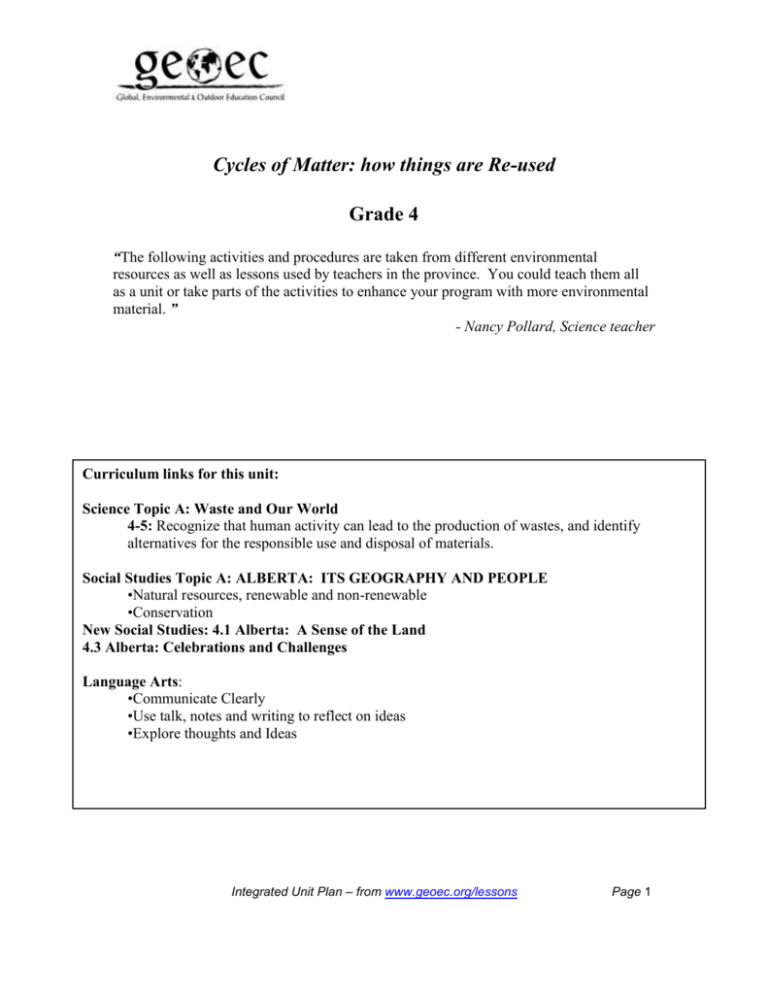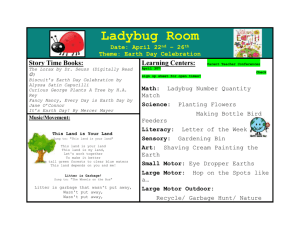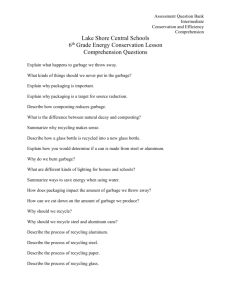grade4-theme1
advertisement

Cycles of Matter: how things are Re-used Grade 4 “The following activities and procedures are taken from different environmental resources as well as lessons used by teachers in the province. You could teach them all as a unit or take parts of the activities to enhance your program with more environmental material. ” - Nancy Pollard, Science teacher Curriculum links for this unit: Science Topic A: Waste and Our World 4-5: Recognize that human activity can lead to the production of wastes, and identify alternatives for the responsible use and disposal of materials. Social Studies Topic A: ALBERTA: ITS GEOGRAPHY AND PEOPLE •Natural resources, renewable and non-renewable •Conservation New Social Studies: 4.1 Alberta: A Sense of the Land 4.3 Alberta: Celebrations and Challenges Language Arts: •Communicate Clearly •Use talk, notes and writing to reflect on ideas •Explore thoughts and Ideas Integrated Unit Plan – from www.geoec.org/lessons Page 1 Activity: Review the food web and focus on the decomposers Time: 15 minutes Background: A food web is a series of interacting food chains. Food chains show the order in which animals consume food. Food chains and food webs are made up of Producers, Consumers, and Decomposers. Instructions for the Teacher: Review the food web and focus on the decomposers using the following definitions as guidelines. Producers: Plants pull nutrients from the soil and transform these nutrients into matter that animals, fungi, or bacteria can use. Consumers: Animals or other organisms that consume (eat) something. Consumers eat producers (plants) or other consumers. An animal that eats a plant is a primary (first level) consumer. An animal that eats an animal that eats plants is a secondary (2nd level) consumer Decomposers: Animals, fungi, or other organisms that break down animal or plant matter after it dies. This puts minerals back into the soil for plants to use again. Using the information above, and the example of a food web below have the students design their own food web, using at least 10 organisms from the url: http://www.fcps.k12.va.us/StratfordLandingES/Ecology/mpages/lesson_1___foodweb.ht m There are endless combinations to choose from. They can illustrate their food web on a large piece of paper or poster board. Ensure they label each organism correctly and draw arrows clearly. Arrows should point to the animal that is doing the eating (Note: Some animals can eat each other. For example, an adult Bullfrog may eat a Crayfish, but the Crayfish will eat Bullfrog eggs or young). Integrated Unit Plan – from www.geoec.org/lessons Page 2 Sample Food Web: The example above is a simple food web showing how some consumers eat some producers and other consumers. There is an earthworm, which is a decomposer, that gets eaten by consumers. In turn, the earthworm eats decaying plant material from the plants. This activity is taken from: http://www.fcps.k12.va.us/StratfordLandingES/Ecology/mpages/lesson_1___foodweb.ht m Debrief the decomposer and it’s role in “cycles of matter”. Integrated Unit Plan – from www.geoec.org/lessons Page 3 Activity: Set up a worm composter in the classroom Time: 30 minutes Instructions for the Teacher Setting up a worm compost is a great way to teach about waste management as well as decomposition! You can buy the red wrigglers from Clean Calgary…and probably many other places throughout Alberta. For more info, or to get your composter started: • Clean Calgary – (403) 230-1443 www.cleancalgary.org Clean Calgary has everything you need for vermicomposting. They also have workbooks for teachers (i.e. “ worms eat our garbage”). They offer an interactive presentation for Calgary schools called “waste in our world part 1.” • Vermicomposting: Let the Worms Do It! - http://perc.ca/PEN/1992-10/5r.html Activity: trip to the dump* Time: 20 minutes – half day* Instructions for the Teacher: 1. Using the board or an overhead, write out student ideas of what plant, animal and human waste is. 2. Explore the concept: “there is no away” and discuss where our waste goes. Field Trip: Take a trip to the local garbage dump! This has a huge impact on students* Post-Trip Questions for students: 1. What type of garbage did you see? 2. From all the garbage you saw at the dump…how much “recyclable” material was there? 3. What alternatives could there be to all the garbage you saw at the dump? 4. What will happen when this “dump” is filled up? Integrated Unit Plan – from www.geoec.org/lessons Page 4 Activity: Garbage-free lunch Time: approx. 20 minute over 2 days Instructions for the Teacher: Count how many pieces of garbage each student has in their lunch. Now, plan to have a “garbage free lunch” and count how many pieces of garbage each student has. Discussion topics before students bring in their “garbage free lunch.” Tips for students on how to minimize their waste: • reusable containers • ask mom or dad not to buy foods with lots of excess packaging (i.e. “lunchables vs cutting up cheese and crackers) • other ideas? Explore other actions people take to minimize the production of wastes Activity: Packaging and waste problems Time: 20 minutes Instructions for the Teacher: 1. Compare different kinds of packaging and infer the relative advantages and disadvantages of that packaging. In evaluating different forms of packaging, students should demonstrate the ability to consider a consumer perspective as well as an environmental perspective. (Science topic A-5) Display different types of packaging on a table, for example, boxes of cereal, “lunchables”, styrofoam chips used for packing, plastics, etc. Have a class discussion on the packaging. Tell the “deer” story: “A deer was found dead in a provincial park. It was starved to death. After they did an autopsy to reveal the cause of death, do you know what they found? ………. A candy wrapper blocking its intestine.” 2. Letter writing: Have the students write a letter to the local grocery store about the Integrated Unit Plan – from www.geoec.org/lessons Page 5 packaging. Or, to the individual companies. Here is an incentive for them: McDonalds stopped using styrofoam years ago because of students writing letters to the company declaring how bad styrofoam was for the environment and requesting that they use a different packaging for their burgers…and they did! Activity: Alberta’s environment Time: two or three 30 minute segments Instructions for the Teacher: 1. Litter survey: Look out the classroom window or tour the schoolyard and take a survey of how much litter there is. Ask students how this makes them feel? Talk about what Albertans do to minimize waste and litter problems. (bottle deposits, tetra pack deposits, milk jug recycling, “keep our parks clean” campaigns.) What can each student do to help promote conservation and decrease litter? What are the 3 R’s? This would also be a good opportunity to talk about renewable and non-renewable energy. If we reduce the amount of litter how will this reduce our use of non-renewable energy (i.e. plastics – petroleum, paper – trees)? This discussion should focus on Albertan’s recycling and re-using. 2. Litter pick-up in the schoolyard: after the above survey and discussion on how all the waste and litter can be minimized, have students “get out there” and clean it up. This is a great stewardship activity that makes the students feel as if they are contributing to a cleaner community. (warn students not to pick up glass, needles or any latex gloves) Brainstorm with the students what to do so litter doesn’t accumulate again (this might include visiting other classes to talk to students about the litter). Remember the deer story? (“A deer was found dead in a provincial park. It was starved to death. After they did an autopsy to reveal the cause of death, do you know what they found? ………. A candy wrapper blocking it’s intestine.”) Integrated Unit Plan – from www.geoec.org/lessons Page 6 Activity: Four R’s Relay (taken from Environmentally Tuned to the Biggest Classroom of them all) Time: 20 minutes Materials: (lots) • all sorts of garbage • two big bins and 10 small bins • coloured tokens Instructions for the Teacher: This activity is to familiarize students to proper categorization of garbage according to the four R’s: Reduce, Reuse, Refuse, Recycle. Divide students into two groups and set them up as shown below: reuseable reduceable students XXXXXXXXXXXXXXXXX refusable Garbage Container recyclable Compost XXXXXXXXXXXXXXXXXX students Review the four R’s concept with your students: First, we want to Refuse certain items, like excess packaging, then Reduce, by consuming less, then Reuse, by using plastic containers in our lunches, and finally Recycle or compost everything possible. To start the relay, the first students take a piece of garbage from the bin and run to the “recycle centre” where there are five other bins each titled: Reuse, Refuse, Reduce, Recycle and Compost. As the students run to the recycle centre, they must decide which bin to place their garbage item into. If they are correct, the “judge” gives them a red token. If they are wrong and must correct themselves once, they get a blue token. If they need to correct themselves twice, they get a white token from the judge. Once all the garbage has been categorized, discuss and review . To determine the winner, add the points: Red = 15, blue = 10, white = 5 points. Try to encourage students to apply what they learn here to habits in their everyday lives. Integrated Unit Plan – from www.geoec.org/lessons Page 7 Concluding Activity: Un-Nature Trail Time: 30 minutes Instructions for the Teacher Set up a “silent nature walk” in a wooded or natural area (can be a very small area). Using 10 “man-made” objects, hide them along the short trail. For example: hang a broom from a tree branch, stick 10 paperclips halfway into the ground, put a pen in a tree fork…. explain to the students that they will be walking along the trail without talking and they are to look around remember anything they see that “does not belong”. When you have all walked along the trail (without talking or pointing) sit in a circle and ask who saw things that didn’t belong. See if anyone got all 10 objects. See if, among the whole class, if all 10 objects were spotted. Do the walk again this time pointing out each object. Page 4 five minute field trip URL: http://www.geoec.org/lessons/ This activity is great for student’s awareness and observation skills. Other Resources "The Great Spec-tackle" This activity is from the Earth Keepers program. It is a fantastic way for students to understand “cycles of matter” and how things are re-used: “Pinch a speck of a dinosaur; share a speck of water with Cleopatra; inhale a speck of air that Marco Polo breathed. Join representative specks (visible molecules) for their journey through the air, water and soil cycles.” See the url: www.eartheducation.org/sourcebook-conceptual-encounters.asp to order an earth education resource book. Integrated Unit Plan – from www.geoec.org/lessons Page 8







